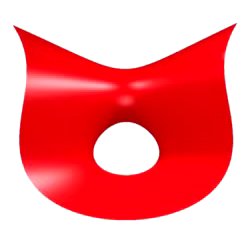FLIPPABLE SURFACE
A flippable surface is a surface globally invariant
under the action of a half-turn (or axial symmetry).
A surface with Cartesian equation  can be identified as flippable if their exists a half-turn r of
can be identified as flippable if their exists a half-turn r of  such that
such that  .
.
With the + sign, the half-turn does not swap the two
faces of the surface; examples:
- all the surfaces
of revolution
- the ellipsoid,
the centered quadrics, and more generally all the surfaces with equation  that are invariant under action of the three half-turns around the axes.
that are invariant under action of the three half-turns around the axes.
- the cross-cap,
and more generally all the surfaces with equation  that are invariant under the action of the half-turn around Oz.
that are invariant under the action of the half-turn around Oz.
With the - sign, the half-turn swaps the two faces of
the surface; taking the axis of the half-turn to be equal to the line  we get a general implicit equation of these surfaces:
we get a general implicit equation of these surfaces:  with
with  ;
examples:
;
examples:
- the plane z = 0
- the Enneper minimal
surfaces, and Costa's minimal surface.
REMARK: all the surfaces of the above box have an equation
of the type  ;
their isometry group is composed of the identity, the half-turn around
Oz
that does not swap the faces, the two half-turns around
;
their isometry group is composed of the identity, the half-turn around
Oz
that does not swap the faces, the two half-turns around  ,
two reflections, and two rotorotations of order 4, this group is isomorphic
to that of the isometries of the square.
,
two reflections, and two rotorotations of order 4, this group is isomorphic
to that of the isometries of the square.
See more generally the surfaces
with rotational symmetry.
© Robert FERRÉOL
2017
